Intel SSD 520 Review: Cherryville Brings Reliability to SandForce
by Anand Lal Shimpi on February 6, 2012 11:00 AM ESTAnandTech Storage Bench 2011
Last year we introduced our AnandTech Storage Bench, a suite of benchmarks that took traces of real OS/application usage and played them back in a repeatable manner. I assembled the traces myself out of frustration with the majority of what we have today in terms of SSD benchmarks.
Although the AnandTech Storage Bench tests did a good job of characterizing SSD performance, they weren't stressful enough. All of the tests performed less than 10GB of reads/writes and typically involved only 4GB of writes specifically. That's not even enough exceed the spare area on most SSDs. Most canned SSD benchmarks don't even come close to writing a single gigabyte of data, but that doesn't mean that simply writing 4GB is acceptable.
Originally I kept the benchmarks short enough that they wouldn't be a burden to run (~30 minutes) but long enough that they were representative of what a power user might do with their system.
Not too long ago I tweeted that I had created what I referred to as the Mother of All SSD Benchmarks (MOASB). Rather than only writing 4GB of data to the drive, this benchmark writes 106.32GB. It's the load you'd put on a drive after nearly two weeks of constant usage. And it takes a *long* time to run.
1) The MOASB, officially called AnandTech Storage Bench 2011 - Heavy Workload, mainly focuses on the times when your I/O activity is the highest. There is a lot of downloading and application installing that happens during the course of this test. My thinking was that it's during application installs, file copies, downloading and multitasking with all of this that you can really notice performance differences between drives.
2) I tried to cover as many bases as possible with the software I incorporated into this test. There's a lot of photo editing in Photoshop, HTML editing in Dreamweaver, web browsing, game playing/level loading (Starcraft II & WoW are both a part of the test) as well as general use stuff (application installing, virus scanning). I included a large amount of email downloading, document creation and editing as well. To top it all off I even use Visual Studio 2008 to build Chromium during the test.
The test has 2,168,893 read operations and 1,783,447 write operations. The IO breakdown is as follows:
| AnandTech Storage Bench 2011 - Heavy Workload IO Breakdown | ||||
| IO Size | % of Total | |||
| 4KB | 28% | |||
| 16KB | 10% | |||
| 32KB | 10% | |||
| 64KB | 4% | |||
Only 42% of all operations are sequential, the rest range from pseudo to fully random (with most falling in the pseudo-random category). Average queue depth is 4.625 IOs, with 59% of operations taking place in an IO queue of 1.
Many of you have asked for a better way to really characterize performance. Simply looking at IOPS doesn't really say much. As a result I'm going to be presenting Storage Bench 2011 data in a slightly different way. We'll have performance represented as Average MB/s, with higher numbers being better. At the same time I'll be reporting how long the SSD was busy while running this test. These disk busy graphs will show you exactly how much time was shaved off by using a faster drive vs. a slower one during the course of this test. Finally, I will also break out performance into reads, writes and combined. The reason I do this is to help balance out the fact that this test is unusually write intensive, which can often hide the benefits of a drive with good read performance.
There's also a new light workload for 2011. This is a far more reasonable, typical every day use case benchmark. Lots of web browsing, photo editing (but with a greater focus on photo consumption), video playback as well as some application installs and gaming. This test isn't nearly as write intensive as the MOASB but it's still multiple times more write intensive than what we were running last year.
As always I don't believe that these two benchmarks alone are enough to characterize the performance of a drive, but hopefully along with the rest of our tests they will help provide a better idea.
The testbed for Storage Bench 2011 has changed as well. We're now using a Sandy Bridge platform with full 6Gbps support for these tests.
AnandTech Storage Bench 2011 - Heavy Workload
We'll start out by looking at average data rate throughout our new heavy workload test:
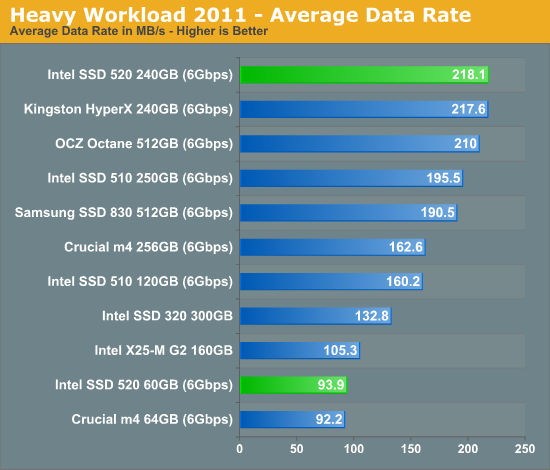
SandForce has always done well in our Heavy Workload test, and the 520 is no different. For heavy multitasking workloads, the 520 is the fastest SSD money can buy. Note that its only hindrance is incompressible write speed, which we do get a hint of in our breakdown of read/write performance below.

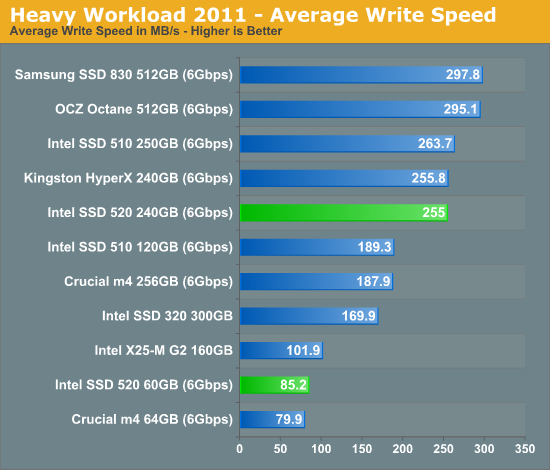
The next three charts just represent the same data, but in a different manner. Instead of looking at average data rate, we're looking at how long the disk was busy for during this entire test. Note that disk busy time excludes any and all idles, this is just how long the SSD was busy doing something:
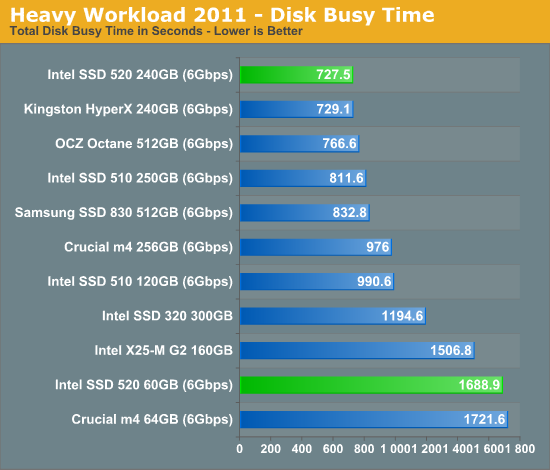
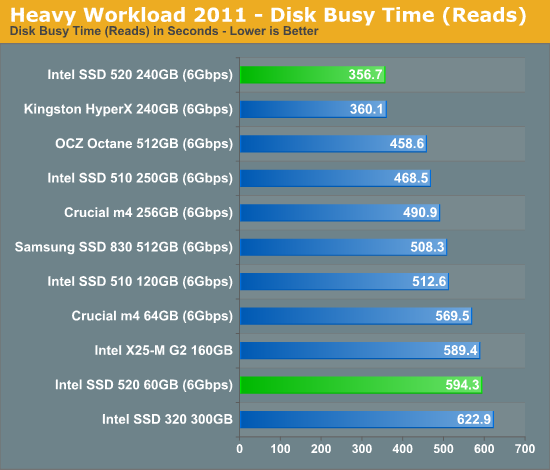
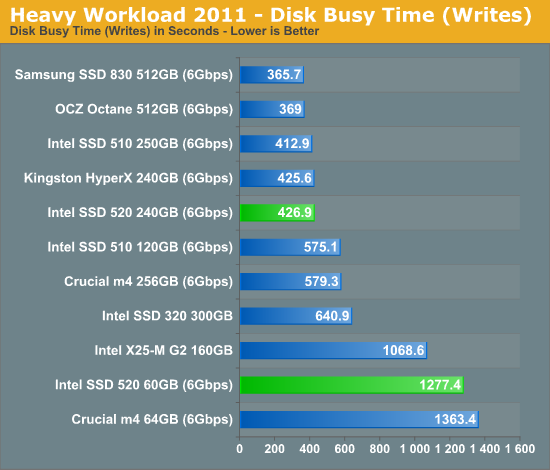










138 Comments
View All Comments
ckryan - Tuesday, February 7, 2012 - link
True, but the 520 series isn't the 320 series. Intel has the 510 and 520 series to satisfy the user that desires speed, but the fact is Intel will sell more SATA II than SATA III drives for the next few years.lyeoh - Tuesday, February 7, 2012 - link
Maybe making fast expensive drives and selling them for profit isn't Intel's main goal. Perhaps Intel is trying to push the SSD market to the next step.Nowadays drives are often the biggest performance bottleneck, and so it stops making a big difference whether you buy a top of the line Intel CPU or not, or even buy AMD instead.
But once fast SSDs start becoming more reliable and sell at closer to _commodity_ prices, then Intel can get back to selling powerful CPUs to more people.
A marketplace full of fast expensive SSDs that BSOD and lose data and slow cheap hard drives doesn't help for such a goal.
But helping Sandforce _eventually_ get their act together (Intel aren't doing this for free of course) might do so. They might also be concerned about Samsung.
NitroWare - Wednesday, February 8, 2012 - link
"Perhaps Intel is trying to push the SSD market to the next step."Intel has frequently done this with different technologies.So it is logical.
In the article, Intel claimed they had 100% of staff on Intel SSD. Vendors usually do not make claims about internal employee hardware.
Ethernet, Wifi, PCI, Legacy free, non x86 ISA (Xscale, Itanic), Fibre, PC I/O and RAM Technologies.
They even dabbled with video conferencing years ago
gramboh - Monday, February 6, 2012 - link
I'm in the market for a 240gb SSD in the next few months, and would love to buy a 520 series over other SF-2281/Marvell options, but right now it's a 42% price premium which is way too much.The 120gb has a more realistic price premium of about 25% (taking into account rebates on the 2281/Marvell drives) which I would consider, would have been nice for Intel to price the 240gb at $400-430.
mckirkus - Wednesday, February 29, 2012 - link
"Would have been nice for Intel to price the 240gb at $400-430"The 240gb version is $357 on Amazon right now (2/29).
LeftSide - Monday, February 6, 2012 - link
I bought the Kingston version on Black Friday for $120 after MIR. It was a great deal. Although I did worry about the BSOD (especially right after sending in the MIR). Thankfully, I haven't had any problems and it has been an excellent drive. It's unbelievably fast.NitroWare - Wednesday, February 8, 2012 - link
They have the 332 firmware available for download from their website. There is even a toolbox utility now but this only has SMART features and no wipe tool.jaydee - Monday, February 6, 2012 - link
Would you expect the 120GB version to perform similar to the 60GB or the 240GB version? Or right down the middle?extide - Monday, February 6, 2012 - link
Historically, 128GB drives have seemed to perform closer to the 240/256GB counterparts than the 60/64GB ones. That's just my observation, though.ckryan - Monday, February 6, 2012 - link
It's closer to the 240GB in performance. The 60GB SF drives are really at a disadvantage, especially in sequential writes. There have been benches of the 120GB 520 for some time, but the 240GB is unquestionable faster. You might not notice the difference in real usage. You can look at Anand's 120GB roundup from last year, and the 120GB version should come out slightly ahead of the Vertex 3.